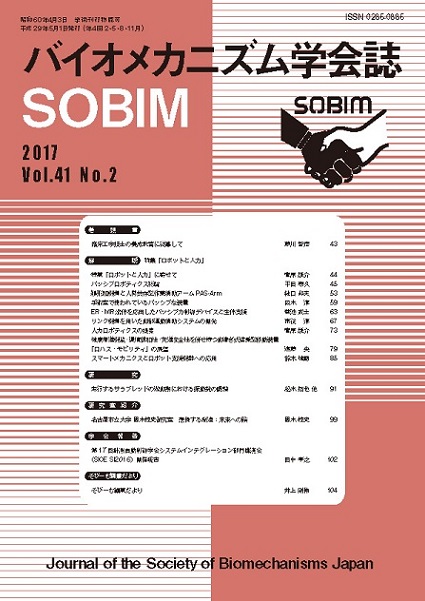All issues

Volume 41, Issue 3
Displaying 1-6 of 6 articles from this issue
- |<
- <
- 1
- >
- >|
Reports
-
[in Japanese]2017 Volume 41 Issue 3 Pages 108
Published: 2017
Released on J-STAGE: August 01, 2018
JOURNAL FREE ACCESSDownload PDF (600K) -
Yoshitaka NAKANISHI, Takashi BABA, Toshiki MORIYAMA, Yuta NAKASHIMA2017 Volume 41 Issue 3 Pages 109-114
Published: 2017
Released on J-STAGE: August 01, 2018
JOURNAL FREE ACCESSThe surfaces of a lotus leaf and moth eye have fine structures that produce a water-repellent effect or reflection suppression. The purpose of this study was to explore the use of surface micromachining to create a bio-inspired surface on artificial materials. A micro slurry-jet was proposed as a removal process for a Co-28Cr-Mo alloy, an acrylic resin and a glass surface. The micro slurry-jet is a wet blasting technique that uses alumina particles as an abrasive medium along with compressed air and water to create fine structures. Although the micro slurry-jet has ultraprecision machining ability in the order of nanometers in the orthogonal direction on a material surface, only sub-millimetric machining accuracy in the parallel direction was realized because of the size limitation of the slurry-jet injection nozzle. A mask operation using microelectromechanical technology, which prevents the removal process by the micro slurry-jet, was also adopted to increase the machining accuracy of a material surface. These methods provided few restrictions on the kind of materials that could be created on a bio-inspired surface, and reduced the pre- and post-treatments of the material surfaces.View full abstractDownload PDF (3364K) -
M. Morales-Hurtado, E. G. de Vries, X. Zeng, E. van der Heide2017 Volume 41 Issue 3 Pages 115-127
Published: 2017
Released on J-STAGE: August 01, 2018
JOURNAL FREE ACCESSA Synthetic Stratum Corneum (SSC) was produced from a mixture of PVA (poly vinyl alcohol) hydrogel and SDS (sodium dodecyl sulphate) surfactant, later mixed with rapeseed oil and, finally crosslinked with glutaraldehyde. The thermal properties of the material were studied via TGA (thermogravimetric analysis) and DSC (differential scanning calorimetry) measurements and the composition was analysed by FTIR (fourier transform infrared). The hydration degree of the SSC measured at 30% of relative humidity and 25°C was 23% whilst at wet conditions it grew up to the 80%. Moreover, the surface adhesion of the SSC, evaluated under dry, normal and wet conditions indicated substantial variations depending on the skin conditions with values for the work of adhesion of -16, -122.4 and -233.4 mN/m, respectively. The viscoelastic properties of the material were also evaluated by tensile tests and stress relaxation measurements. The elastic modulus of the samples was found between 8.8 - 1.9 and 3.3 - 1.2 for dry and wet conditions, respectively. Further, stress relaxation times of 64.4 sec and 83.2 sec were calculated from the SLS (standard linear solid) model at dry and wet conditions, respectively. Lastly, the SSC presented a frictional performance in close agreement to that of human skin under normal (36% relative humidity and 25°C) and wet conditions. The friction coefficient, measured between 1 and 50 mN, was found between 0.8 to 0.45 at dry conditions whereas, at wet conditions, it ranged between 2 and 0.45. At higher applied forces between 0.5-3.5 N, the friction coefficient was nearly steady with values of 0.4 and 0.55 for dry and wet conditions, respectively.View full abstractDownload PDF (1301K) -
Lin LIN, Jiusheng LI, Xiangqiong ZENG2017 Volume 41 Issue 3 Pages 129-136
Published: 2017
Released on J-STAGE: August 01, 2018
JOURNAL FREE ACCESSThe skin, which is known as a complex multi-layered tissue, is vital for protecting the body from potentially harmful external environment and exhibits complex mechanical behaviour. As reported, skin is a non-linear, anisotropic and viscoelastic materials, with its mechanical properties varied in each skin layer and influenced mainly by skin hydration status, environment humidity and test conditions. Therefore, it is difficult to study the mechanical and tribological interactions between human skin and materials for the development of human contacting products. And in order to better understand the mechanical interactions between human skin and various products for optimizing surfaces and materials in contact with human skin, it is significant to use instrumental mechanical and tribological measurements, which could provide objective and more reproducible results without inter- and intra-subject variations. Past decades we have witnessed many endeavors exerted for developing physical skin model to objectively study the interactions between human skin and materials, instead of using in vivo or ex vivo human skin or animal skin. This review article gives an overview of the development of physical skin model for biomechanical applications, in which the progresses made in the synthesis and the following tests of skin-materials interaction were summarised and discussed.View full abstractDownload PDF (777K) -
Ling YIN2017 Volume 41 Issue 3 Pages 137-142
Published: 2017
Released on J-STAGE: August 01, 2018
JOURNAL FREE ACCESSRestorations of missing teeth with aesthetic, biocompatible and reliable prostheses are in high demand in our aging societies. With more dental materials available than ever before, optimal materials selection is critical to the success of restorations. This paper reviews current aesthetic dental ceramics and their reliability. A classification of dental ceramics based on their microstructures is presented, and the mechanical properties of these materials are summarized. This classification gives dental clinicians and patients rapid access to data for current dental materials, and it can be used to find the best material match for a given restoration requirement. Finally, this review addresses failures of ceramic restorations due to the brittle nature of ceramic materials, which are a continuing challenge for mechanical and materials engineers, and for dental clinicians.View full abstractDownload PDF (978K) -
[in Japanese], [in Japanese]2017 Volume 41 Issue 3 Pages 143-148
Published: 2017
Released on J-STAGE: August 01, 2018
JOURNAL FREE ACCESS
- |<
- <
- 1
- >
- >|